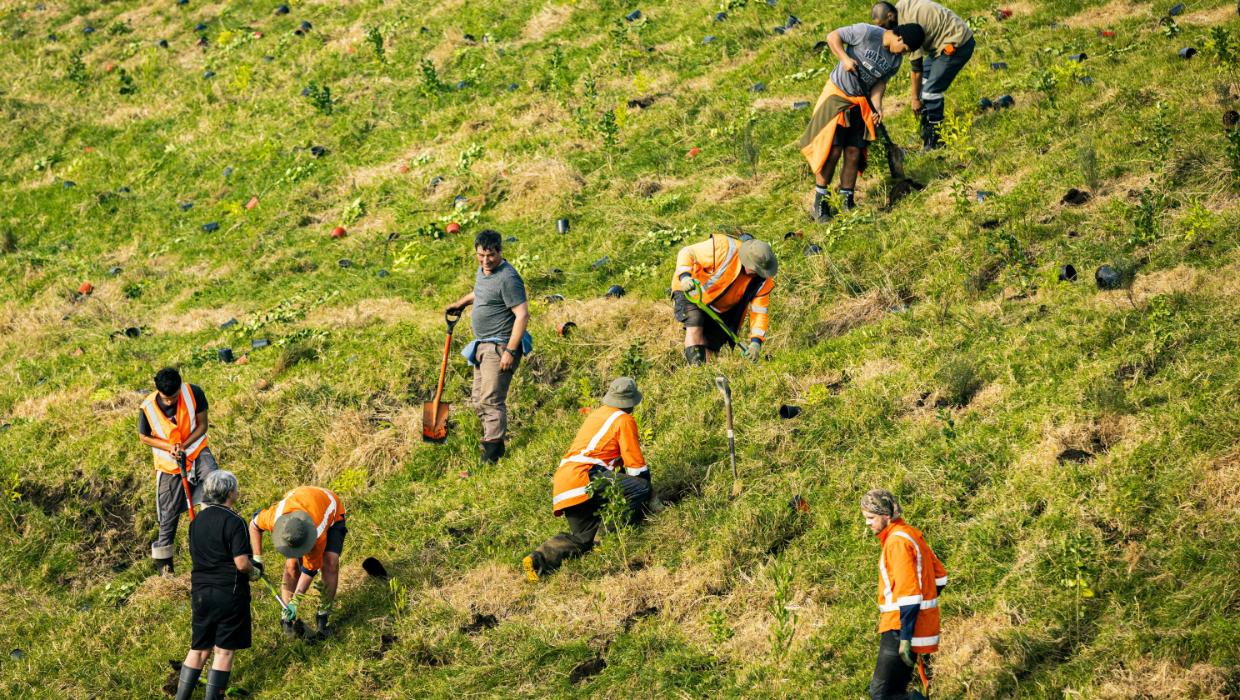New Zealand’s approach at previous COPs has underwhelmed, earning us successive “fossil” awards. These ironically titled awards are given to the countries who are “doing the most to achieve the least” and “doing their best to be the worst” in terms of climate action. Will New Zealand be laughed at or celebrated at COP28?
Top Header Image: A volunteer group does some native planting in New Plymouth.
©Vanessa Laurie/STUFF
If we continue to win fossil awards, there is a very strong possibility that our international reputation will be significantly impacted, with flow-on effects for global relationships, especially for trade.
We must do better because our future generations deserve better.
However, I am optimistic because I believe that Recloaking Papatūānuku is an initiative that can turn Aotearoa from winning fossil awards, to being a world leader.
Recloaking Papatūānuku is an ambitious, catchment-led initiative to strategically restore and enhance more than 2 million hectares of indigenous forests across Aotearoa over the next 10 years. By taking a nature-first approach, it presents an unparalleled opportunity for New Zealand to be a world leader in deploying Nature-based Solutions (NbS) to address the climate emergency.
Recloaking Papatūānuku presents a scalable, cost-effective, co-beneficial opportunity to tackle multiple ecological and climate-related challenges together, whilst also building resilience in our landscapes.
But we must start now. Things are going to get worse before they get better. The sooner we start, the smoother this transition will be. It will require bold leadership and transformative action.
By restoring degraded indigenous forests, and strategically incorporating new plantings alongside existing productive land uses, we can weave climate and ecological resilience into our landscapes, thus mitigating future climate risks.
We can enhance native biodiversity, stabilise fragile soils, and improve freshwater and marine ecosystem health. We can diversify land use and income streams while supporting sustainable food production systems. We can do this while also drawing down historic and hard-to-abate atmospheric CO2. Recloaking Papatūānuku will help New Zealand heal and thrive.
”We’re currently so far behind that Treasury estimates we may be forced to buy up to $24 billion worth of international carbon credits by 2030 to meet our commitments.
There are also cultural, spiritual, mental health, and recreational benefits that will be preserved by restoring our indigenous forests. And the profound natural beauty of our old growth stands can continue to be a source of national identity and pride, for current and future generations.
Securing an enduring, regenerative carbon sink is necessary to achieving net-negative emissions and a nature-positive future. That said, restoring our indigenous forests is not a substitute for deep and urgent emissions reductions, we must do both, now.
Implementing Recloaking Papatūānuku would also reduce New Zealand’s need to rely on international offsets to meet our Nationally Determined Contributions (NDCs) under the Paris Agreement.
We’re currently so far behind that Treasury estimates we may be forced to buy up to $24 billion worth of international carbon credits by 2030 to meet our commitments. Recloaking Papatūānuku is estimated to cost half this amount, and the returns on this enduring investment will continue long into the future. I believe our money should be spent enriching our own environment.

©Josh Griggs
The consequences of inaction are also significant. New Zealand’s recent free trade agreement with the EU suggests that trading partners will increasingly hold each other accountable for their climate commitments. Yet New Zealand’s current climate policies and actions have been assessed as “highly insufficient” by the Climate Action Network. With one of the highest emissions per capita in the OECD, our country is increasingly at risk of being viewed as a laggard. Continued inadequate climate action will have significant implications for New Zealand’s international trade relations, market access, and premium product positioning.
Restoring and enhancing our indigenous forests is an opportunity to bolster the credibility of New Zealand’s clean, green reputation around which the NZ Inc brand has been built, on which our tourism industry depends, and which helps our primary produce command a premium in international markets. By taking the lead on implementing and realising the multiple co-benefits that Recloaking Papatūānuku can deliver, we can aspire to be a truly nature-positive country.
New Zealand could be in line for another fossil award at COP28. But at least the world will also see the work we’ve put into Recloaking Papatūānuku, which is being showcased by Pure Advantage at the conference on behalf of a growing coalition of stakeholders.
Recloaking Papatūānuku is our opportunity to lead the world in nature-based solutions.
This article was also published online by The Press, Waikato Times, The Post.




Leave a comment